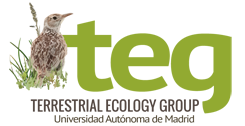
Universidad Autónoma de Madrid
Departamento de Ecología. C-216
Centro de Investigación en Biodiversidad y Cambio Global (CIBC-UAM)
28049 – Madrid (España)
Tfn: +34 91 497 8916
Fax: +34 91 497 8001
E-mail: pablo.acebes(at)uam.es
Algunas publicaciones recientes
Iranzo, E. C., Ohrens, O., Mata, C., Traba, J., Acebes, P., González, B. A., … & Malo, J. E. (2025). More pumas (Puma concolor) does not change perceptions: The mismatched response of ranchers to the presence of a top carnivore. People and Nature. https://doi.org/10.1002/pan3.70018
Zabala, J., Acebes, P., Madeira, M. J., Fernández, E., Gómez-Moliner, B. J., & Cabodevilla, X. (2025). Metabarcoding provides accurate estimation of volumetric diet composition in a top predator despite interference from blocking primers. Scientific Reports, 15(1), 29033. https://doi.org/10.1038/s41598-025-14837-9
Acebes, P., Muñoz‐Gálvez, F. J., Iglesias‐González, Z., García‐Llorente, M., & López‐García, D. (2024). Unveiling human–wildlife interactions in the context of livestock grazing abandonment and the return of large carnivores, ungulates and vultures: A stakeholder perspective. People and Nature. https://doi.org/10.1002/pan3.10769
Pérez, C., Acebes, P., Franco, L., Llusia, D. & Morales, M. B. (2023). Olive grove intensification negatively affects wintering bird communities in Central Spain. Basic and Applied Ecology, 70: 27-37. https://doi.org/10.1016/j.baae.2023.04.005
Acebes, P., Vargas, S. & Castillo, H. (2022). Sarcoptic mange outbreaks in vicuñas (Cetartiodactyla: Camelidae): a scoping review and future prospects. Transboundary and Emerging Diseases, 69(5): e1201-e1212. https://doi.org/10.1111/tbed.14479
Acebes, P., Alba-Iglesias, Z. & Muñoz-Galvez, F. (2021). Do Traditional Livestock Systems Fit into Contemporary Landscapes? Integrating Social Perceptions and Values on Landscape Change. Agriculture, 11(11): 1107. https://doi.org/10.3390/agriculture11111107
Grace, M.K., Akçakaya, R., Bennett, E.L.,…Acebes, P.,…& Young, S. (20/204). (2021). Testing a global standard for quantifying species recovery and assessing conservation impact. Conservation Biology, 35 (6): 1833-1849. https://doi.org/10.
Pozo, R.A, Cusack, J.J., Acebes, P., Malo, J.E., Traba, J., Iranzo, E.C., Morris-Trainor, Z., Minderman, J., Bunnefeld, N., Radic, S., Moraga, C., Arriagada, R. & Corti, P. (2021). Reconciling livestock production and wild herbivore conservation: challenges and opportunities. Trends in Ecology & Evolution, 36: 750-761. https://doi.org/10.1016/j.tree.2021.05.002
Acebes, P., Lillo, P. & Jaime-González, C. (2021). Disentangling LiDAR Contribution in Modelling Species–Habitat Structure Relationships in Terrestrial Ecosystems Worldwide. A Systematic Review and Future Directions. Remote Sensing, 13(17): 3447. https://doi.org/10.3390/rs13173447
Mezquida, E.T., Caputo, P., & Acebes, P. (2021). Acorn Crop, Seed Size and Chemical Defenses Determine the Performance of Specialized Insect Predators and Reproductive Output in a Mediterranean Oak. Insects, 12(8): 721. https://doi.org/10.3390/insects12080721
Acebes, P. & Grace, M. (2021). Beyond the Red List of Threatened Species: The IUCN Green Status of Species as a tool to assess their conservation success. First data for South American Wild Camelids. IUCN SSC GECS News, 8: 4-11.
Iranzo, E.C., Traba, J., Mata, C., Acebes, P. & Malo, J.E. (2021). Habitat structure and association with ungulates drive habitat selection and grouping behaviour of lesser rhea (Rhea pennata subsp. pennata). Austral Ecology, 46: 86-97. https://doi.org/10.1111/aec.12961
Puedes ver una lista más completa en:
ResearchGate: http://www.researchgate.net/profile/Pablo_Acebes/
Google Académico: http://scholar.google.com/citations?user=YdNVnF4AAAAJ&hl=es

